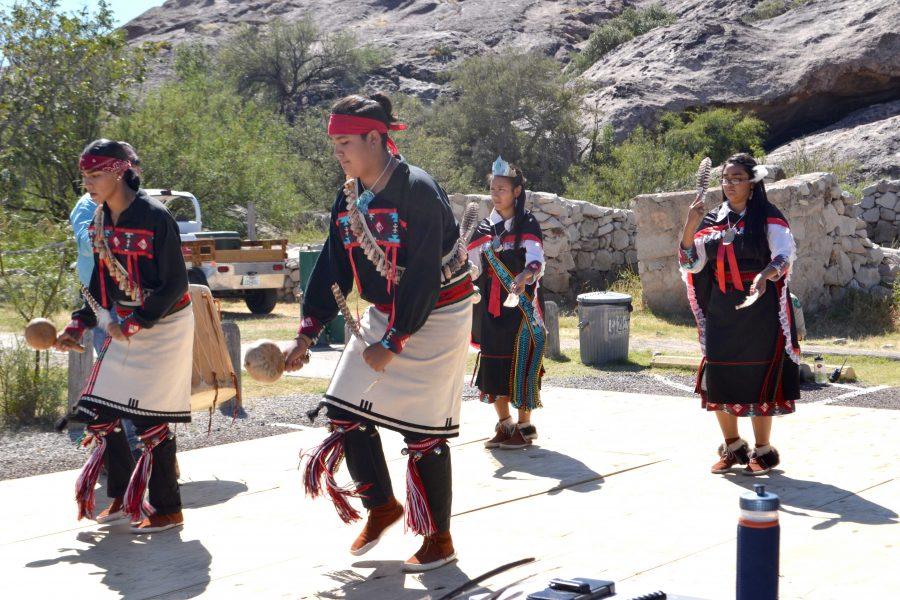Hueco Tanks State Park and Historic Site opened its grounds Oct. 15 and 16 for its 22nd annual Interpretive Fair, which was a weekend of free hikes, tours and exhibitions on the native people, wildlife and natural landscape.
Hueco Tanks stand as a geological formation of surfaced magma exposed by wind and erosion over millions of years. These massive mounds of igneous rock hollow out areas with less density, which creates small bowls or reservoirs that collect rainwater.
Rick Quezada is the director of cultural preservation for Ysleta Del Sur Pueblo. During the fair, he lead a discussion on the native people, including his own, that chose to settle there. According to Quezada, these reservoirs were one of the few sources of water.
“There are these huge pockets in the rock where rainwater would fall, and what my people did is dam up one end to keep the water from flushing out. So when it would rain it would catch fresh rainwater,” Quezada said. “Geologists have taken dimensions of the tanks my people used to use and say the bigger ones could hold up to 50,000 gallons of water.”
From 50,000 gallons to small bowls of water, these reservoirs have been the catalysts that bring life to Hueco Tanks.
“Where there is water there is wildlife,” Quezada said.
It is a simple fact that life cannot thrive without water, so simple that it might come off as cliché, but the change of vegetation as you get closer to the Tanks’ reinforces this fact. As Quezada explained, the early Tiguas settled at Hueco Tanks because of the variety of plants the area had to offer.
“This was our grocery store, our pharmacy,” Quezada said. “There are a lot of plants here that have medicinal properties. People catch a cold and they head to WalMart for cough medicine, when maybe all they need is some creosote.”
He pointed to an unsuspecting bush with furry seeds no bigger than raisins. When they are crushed, the fragrance is like rain,which is released after a rain shower.
“You wash this, like a shot glass full,” Quezada said. “Boil it with some coffee and it really helps with allergies.”
Along with Quezada’s Ysleta del Sur’s tribesmen, the Danza Apache San Judas Tadeo, the Mescalero Apache Youth Dancers and the Danza Azteca–Chichimeca Tlaneztica exhibited their culture’s ritualistic dances performed in preparation for harvest, rain or planting.
Knowledge about the natural landscape seemed to be the main theme of the fair. The weekend was a blend of geology, birding and rare plant hiking tours and trips to nearby caves with tribal pictographs still visible on the cave walls. The tours were led by scientists or enthusiasts, who were more than willing to spout any knowledge on their area of study.
What may seem like a well-known fact can actually be a common misconception.
An advocate for the resurgence of the Mexican wolf is Nancy Bain who explained that their disappearance can lead to a chain reaction that may even harm humans.
“Elk have a disease called chronic wasting disease that takes years to develop and rots the brain,” Bain said. “Although the Mexican wolf may prey on diseased and older elk, they only live six to eight years so it doesn’t affect them. So the wolf makes the herd healthier by keeping the disease from spreading, which in turn keeps the hunter from eating infected meat.”
Hidden gems of information like this were rampant throughout the fair.
Close by the fair’s home base, park rangers scattered throughout the area were involved in conversations about the site’s local wildlife while others showed children which plants make the best bow or which ones were edible. These rangers contributed to the atmosphere of the fair, one of reverence and admiration for all aspects of nature.
Park ranger Gina Hernandez said that although she herself was not looking closely enough when she first joined the park rangers, her time in national state parks has taught her about our connection with nature.
“The desert is not majestic like big redwood trees, but the more you stay there and you see the cycle of seasons and the small differences in plants, it has its own subtle beauty that you have to get to know,” Hernandez said. “So as I learned about it, I appreciated more. That’s what I’m trying to do, help people connect to those things and appreciate the resources at the 413 parks in the country.”
Although Hernandez spends time at Hueco Tanks, her specific park assignment is the Chamizal National Memorial. Like the natural landscape of Hueco Tanks, Chamizal’s history is a reason why Hernandez advises people to explore national parks.
“Chamizal is a monument to two countries (US and Mexico) solving their issues diplomatically,” Hernandez said. “Especially with this election, it’s nice to know that solving problems through diplomacy can still be done.”
The Hueco Tanks State Park and Historic Site holds the Interpretive Fair once a year in the third week of October, but their willingness to share information and hikes occurs year-round.
For more information on Hueco Tanks and a calendar of future hikes and tours, visit tpwd.texas.gov/state-parks/hueco-tanks.









